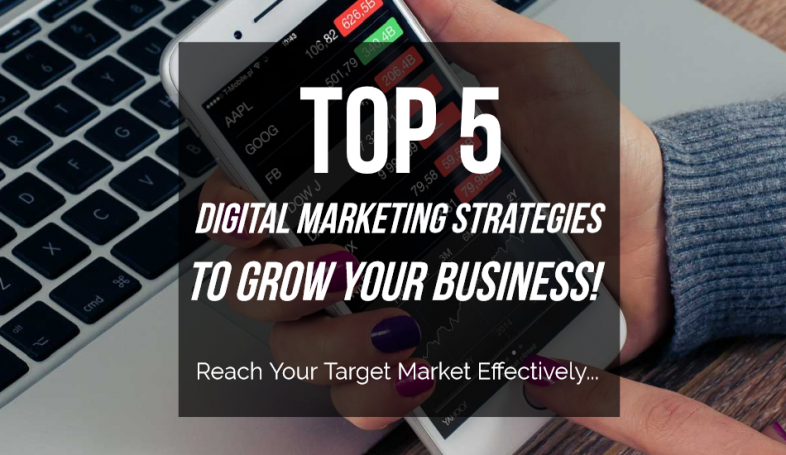Welcome everyone to my Top 5 Digital Marketing Strategies. Now let’s get going with this comprehensive strategy guide!
In an ever changing world of digital marketing strategies, crafting a robust content marketing strategy is a critical step in obtaining meaningful connections with your target audience and driving sustainable business growth.
In this section, we’ll dive into the key components of an effective content marketing strategy. Exploring essential steps from defining your target audience and to optimizing content distribution for maximum results.
The first building block of any successful digital marketing strategy lies in understanding and defining your target audience. Conduct thorough market research to identify the demographics, interests, and the pain points of your ideal customers.
By creating content that resonates with your audience, you set the stage for the most engagement and brand loyalty.
In depth keyword research is the tool that will guide you through your content creation efforts. Identify the most relevant keywords and phrases that align with your business goals. They must resonate with your audience’s search intent.
Utilize tools like the Google Keyword Planner to uncover valuable insights and ensure your content is highly optimized for search engines.
Quality is paramount in the world of content marketing. Craft content that is not only informative but also provides the solution to your audience’s needs. Whether it be through blog posts, videos, infographics, or a combination of formats, be sure your content adds value and addresses their pain points.
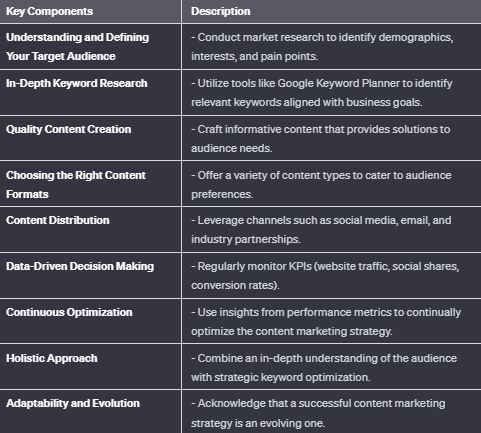
Now at this point, it’s important to choose the right formats for your content in order to cater to your audience’s preferences. For example, some people would rather consume information through articles, while others may engage more with videos or infographics. By offering a variety of content types you enhance your reach and engagement across many audience segments.
As you may know, content distribution is as crucial as content creation. Leveraging various channels such as social media, email and industry partnerships to increase your content’s reach. Set your distribution strategy to align with the preferences of your target audience, being sure that your content meets them where they are.
Using data driven decision making is essential to refining your content marketing strategy. Regularly monitoring key performance indicators (KPIs) such as website traffic, social shares, and conversion rates. Analyze this data to gain insights into what resonates with your audience and make adjustments to your strategy accordingly.
Having a successful content marketing strategy is an evolving one. Use the insights gained from performance metrics to optimize your approach continually. Experiment with different content angles, formats, and distribution channels to refine your strategy and stay ahead in the ever competitive digital landscape.
Mastering the art of content marketing requires a holistic approach that combines an in depth understanding of your audience. This will also include, strategic keyword optimization and a commitment to delivering high quality, valuable content.
By following these key steps in crafting and implementing your content marketing strategy, you’ll not only boost your online visibility. But you will also cultivate lasting relationships with your audience, driving sustained business success!
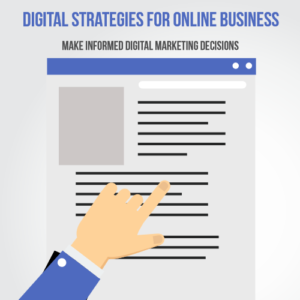
Digital Marketing Strategies For Social Media
Now we need to address another one of my digital marketing strategies. Harnessing the power of social media is not negotiable for businesses striving to connect with their audience on a personal level.
This section unveils essential social media marketing tactics that can elevate your brand’s visibility, foster engagement and pave the way for impactful business outcomes.
Not all social media platforms are created equal, and choosing the right ones for your business is the first strategic move. You will need to find out where your target audience is most active.
Whether it’s the visual allure of Instagram, the professional network of LinkedIn or the conversational space of Twitter. Align your brand with platforms that resonate most with your audience!
With social media, the key is consistency. You will need to develop a content calendar to plan and schedule your posts in advance. This ensures a steady flow of content that aligns with your brand messaging and keeps your audience engaged.
A well organized content calendar also allows for strategic alignment with events, holidays and industry trends.
Engagement is the heart and soul of your digital marketing strategies. Spice up your content with interactive elements such as contests and polls. This will push your audience to share and interact with your business. This is essential because, it not only boosts engagement but also extends your reach as users share their participation with other networks.
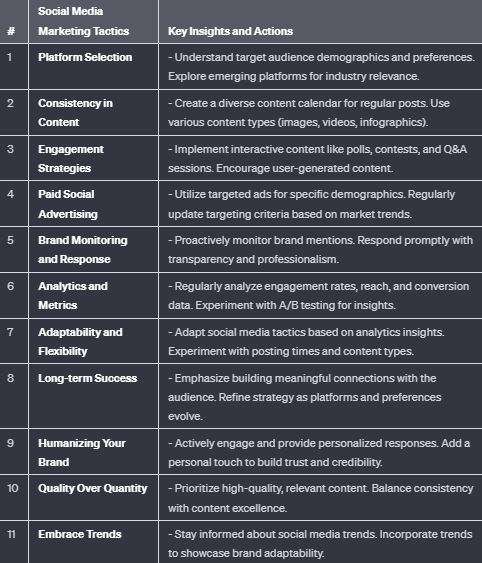
While organic reach is valuable, strategic use of paid social advertising can amplify your brand’s visibility. Start investing in targeted social media ads to reach specific demographics, interests and behaviors.
Utilize the powerful targeting tools provided by platforms like Facebook and Instagram to be sure that your content reaches the right audience.
In order to build a strong online presence, you must be actively monitoring your brand’s mentions on social media. Respond promptly to comments, mentions and messages. This not only demonstrates a commitment to customer service but also humanizes your brand.
Addressing both the positive and negative mentions with transparency and professionalism can and will build trust and credibility.
Regularly analyze metrics such as engagement rates, reach and conversion data. Do some research to discover what type of content that is being consumed and be sure to adjust your strategy right away. Using tools like Facebook Insights and Twitter Analytics offer valuable data for informed decision making.
Based on the insights from analytics, be prepared to adjust your social media tactics. Experiment with different posting times, content types and engagement strategies. This approach ensures that your social media efforts remain dynamic and responsive to the evolving preferences of your audience.
Boosting your brand through social media requires a strategic blend of platform selection, consistent content creation and active engagement.
By implementing these key social media marketing tactics, you not only enhance your brand’s visibility but also foster meaningful connections with your audience. This drives long term success in the digital landscape!
Search Engine Optimization (SEO) Strategies
Learning the art of Search Engine Optimization (SEO) is paramount to unlocking the gateway to online visibility and success. In this part, I give you my essential SEO techniques, that will help guide your business through the intricate process of optimizing a digital presence to secure top rankings on search engine results pages.
The foundation of any effective SEO strategy begins with comprehensive keyword research. Identify and target keywords relevant to your business, products and services.
Leverage tools such as Google Keyword Planner to unearth valuable insights into search volumes, competition and user intent. This strategic approach ensures your content aligns seamlessly with the queries of your target audience.
Knowing that on page elements are a critical facet of SEO, you will need to draft compelling meta tags, including title tags and meta descriptions. Ensure headers are appropriately structured, enhancing both user experience and search engine readability.
A well optimized page not only attracts users but also appeals to search engine algorithms, contributing to improved rankings.
Content still remains king in the digital world and creating high quality, shareable content is huge for SEO success. Develop content that not only addresses user queries but also provides value and solutions. Shareable content attracts natural backlinks, a key factor in search engine algorithms.
Whether it’s informative blog posts, engaging videos or visually appealing infographics, you must prioritize content that resonates with your audience.
Backlinks serve as digital endorsements, signaling to search engines the credibility and authority of your content. Every business needs to implement a strategic link building campaign to acquire high quality backlinks from reputable sources within your industry.
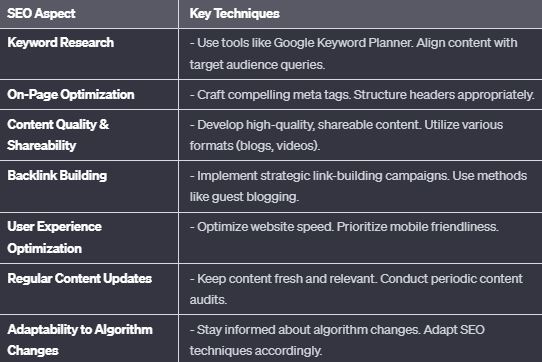
Guest blogging, influencer collaborations, and participation in online communities are effective methods to cultivate a network of authoritative backlinks.
Search engines look at user experience, so it’s important to consider the following. Optimize your website for speed to ensure swift loading times, reducing bounce rates and enhancing user satisfaction.
Additionally, prioritize mobile friendliness as mobile devices dominate online searches. Responsive design and mobile optimization contribute not only to improved rankings but also to a positive user experience across diverse devices.
Search engines favor fresh and relevant content. Be sure to regularly update and maintain your website content to reflect industry trends, changes and evolving user needs. This proactive approach signals to search engines that your site is dynamic and remains a valuable resource. Periodic content audits and updates contribute to sustained visibility and rankings.
Algorithms change often! Adapt your SEO techniques to align with these changes, ensuring your strategies remain effective and compliant. Staying informed allows you to proactively adjust your approach and maintain optimal visibility in search engine results.
Effective SEO techniques require strategic planning, adaptability and a commitment to delivering valuable content. By incorporating these essential SEO practices into your digital strategy, you not only optimize your online presence for search engines but also position your business for sustained success.
Email Marketing Is A Great Strategy
In the space of digital marketing strategies, where personalized engagement is the key to success, mastering the art of email marketing is paramount. This section will unravel the core principles and best practices that can elevate your email marketing strategy.
Fostering meaningful connections with your audience and driving conversions!
The foundation of effective email marketing lies in the quality of your email list. Instead of casting a broad net, focus on building a targeted and segmented list. Understand your audience’s preferences, behaviors and demographics to create segments.
This tailored approach will allow you to deliver content that resonates with specific audience segments, enhancing engagement and conversion rates.
Personalization is the heartbeat of successful email marketing. Craft emails that speak directly to your audience, addressing their needs, preferences and pain points.
Utilize personalized salutations, dynamic content and tailored offers to create a sense of individual connection. A personalized approach not only captures attention but also builds trust and loyalty.
As you know, the email subject line is the gateway to your content. Craft compelling and intriguing subject lines that entice your recipients to open your emails. Start by experimenting with different approaches, such as urgency, curiosity, or benefit driven language in order to discover what resonates most with your audience.
A high open rate is a crucial indicator of a successful email marketing campaign!
It’s important to incorporate eye catching visuals, graphics and multimedia elements to enhance the visual appeal of your emails. A well designed email not only captures attention but also communicates information more effectively. Ensure your visuals are mobile responsive for a seamless experience across all devices.
Fine tune your email campaigns through A/B testing. Experiment with variations in subject lines, content, images, and calls to action. Identify the elements that resonate most with your audience.
A/B testing provides lots valuable insights into what drives engagement and conversions, allowing you to optimize your future email campaigns for better results.
It can’t be stated enough that you must maintain a clean and engaged email list to avoid being flagged as spam. Regularly monitor deliverability metrics and promptly address any issues.
Provide clear unsubscribe options and adhere to anti-spam regulations to ensure your emails reach the intended recipients inboxes.
Here is the part where to can go over key metrics to gain a deep understanding of how your audience interacts with your emails and use this information to refine your content, segmentation and overall strategy for continuous improvement.
To elevate your email marketing strategy from ordinary to extraordinary, you will need a blend of precision, personalization and a commitment to delivering value. By adhering to these best practices, you not only optimize your email campaigns for success but also cultivate lasting connections with your audience.
This transforms email communication into a powerful tool for business growth.
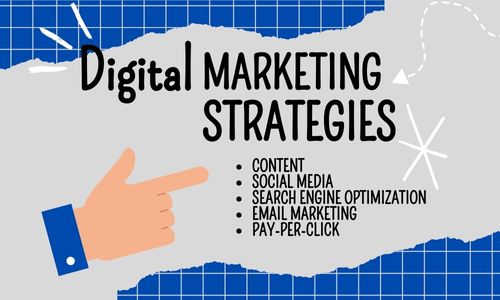
Pay-Per-Click (PPC) Advertising Strategies
In the fast paced world of digital marketing strategies, understanding Pay-Per-Click (PPC) is imperative for businesses seeking immediate and targeted visibility. Now let’s explore key PPC advertising tips that can empower your campaigns, ensuring optimal returns on investment and driving tangible business results.
The foundation of a successful PPC campaign is rooted in comprehensive keyword research. Identify and target keywords that align with your business goals and resonate with your audience’s search intent.
Leveraging tools like Google Keyword Planner to uncover high value keywords and gain insights into search volumes and competition. A well researched keyword strategy is crucial for a high performing PPC campaign.
Crafting ad copy that captures attention and communicates value is essential for PPC success. You need to develop compelling headlines and concise, benefit driven ad copy that aligns with user intent.
Highlight unique selling propositions and incentivize clicks by including special offers or promotions. A well crafted ad not only attracts clicks but also ensures a positive user experience.
You can boost relevance by including ad extensions. These additional snippets of information such as site links, call outs and structured snippets, provide users with more context and reasons to click. Ad extensions not only improve the visibility of your ads but also contribute to higher click through rates and improved ad rank.
Effectively managing your budget is a cornerstone of successful PPC advertising. Set a realistic budget based on your business objectives and allocate funds strategically across campaigns and ad groups.
Implement bidding strategies that align with your goals, whether it’s maximizing clicks, optimizing for conversions or focusing on return on ad spend (ROAS). Regularly monitor and adjust your bids to ensure optimal campaign performance.
Make decisions based on data. This is a fundamental principle in PPC advertising. Regularly monitoring key performance metrics such as click through rates, conversion rates and cost per conversion.
Analyze this data to identify top performing campaigns, ad groups and keywords. Use these insights to adjust your strategy, reallocating budget to high performing elements and optimizing those that are under performing.
So at this point, you don’t miss out on potential conversions from users who have previously interacted with your website. Time to start implementing a re-marketing campaign to re-engage visitors and encourage them to complete desired actions.
Tailor your ads to address their specific interests or showcase products they viewed. Re-marketing not only boosts conversion rates but also reinforces brand awareness among your target audience.
The digital advertising landscape is dynamic with constant updates and innovations. Stay informed about industry trends, changes in ad platforms and emerging technologies. Regularly update your PPC strategy to align with the latest features and opportunities offered by platforms like Google Ads and Bing Ads.
Staying ahead of the curve ensures your campaigns remain competitive and effective!
Grasping the art of PPC advertising requires a strategic blend of keyword research, compelling ad copy and data driven optimization. By incorporating these essential tips into your PPC strategy, you not only maximize your returns on investment but also position your business for sustained success in the competitive digital advertising space.
Alright so there you have it for my Top 5 digital marketing strategies guide! Please feel free to leave a comment below. I would love to know how you are using these for your own business ventures!

